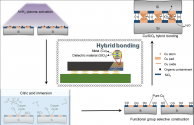Low-temperature Cu/SiO2 hybrid bonding based on Ar/H2 plasma and citric acid cooperative activation for multi-functional chip integration.
Abstract
Cu/SiO2 hybrid bonding is a crucial technique for three-dimensional (3D) integration, which can greatly shorten the interconnected spacing by metal-electrode (Cu) and insulator (SiO2) hybrid interfaces without requiring microbumps. By this bumpless hybrid bonding, the vertical stack of devices with ultrahigh density can be accomplished to meet the demand of high-performance artificial intelligence (AI) chips. To improve the compatibility for multi-functional chip integration, low-temperature bonding conditions are essential. Moreover, it is a great challenge to achieve oxide-free Cu/Cu bonding interface as well as ensure SiO2/SiO2 bonding with sufficient hydroxylated groups. Therefore, we proposed a two-step cooperative activation process as argon and hydrogen gas mixture (Ar/H2) plasma activation followed by citric acid treatment, which makes the Cu oxide reduction and SiO2 hydroxylation simultaneously. The low-cost Cu/SiO2 hybrid bonding was successfully obtained at 200 °C in ambient air. There were nearly neither oxides at Cu/Cu bonding nor residual carbon at SiO2/SiO2 bonding interfaces. More interestingly, the bonding pairs not only survived in the aging tests in the range of 150–350 °C, but the bonding area and strength were further improved. Consequently, this two-step cooperative activation process has great potential for low-temperature Cu/SiO2 hybrid bonding with high-temperature reliability.


